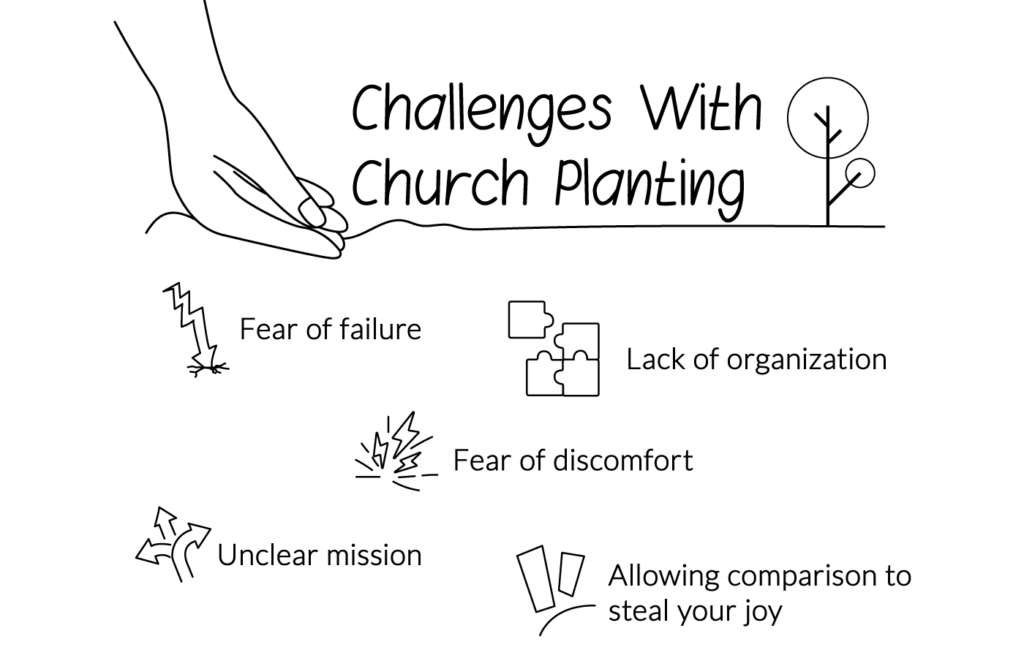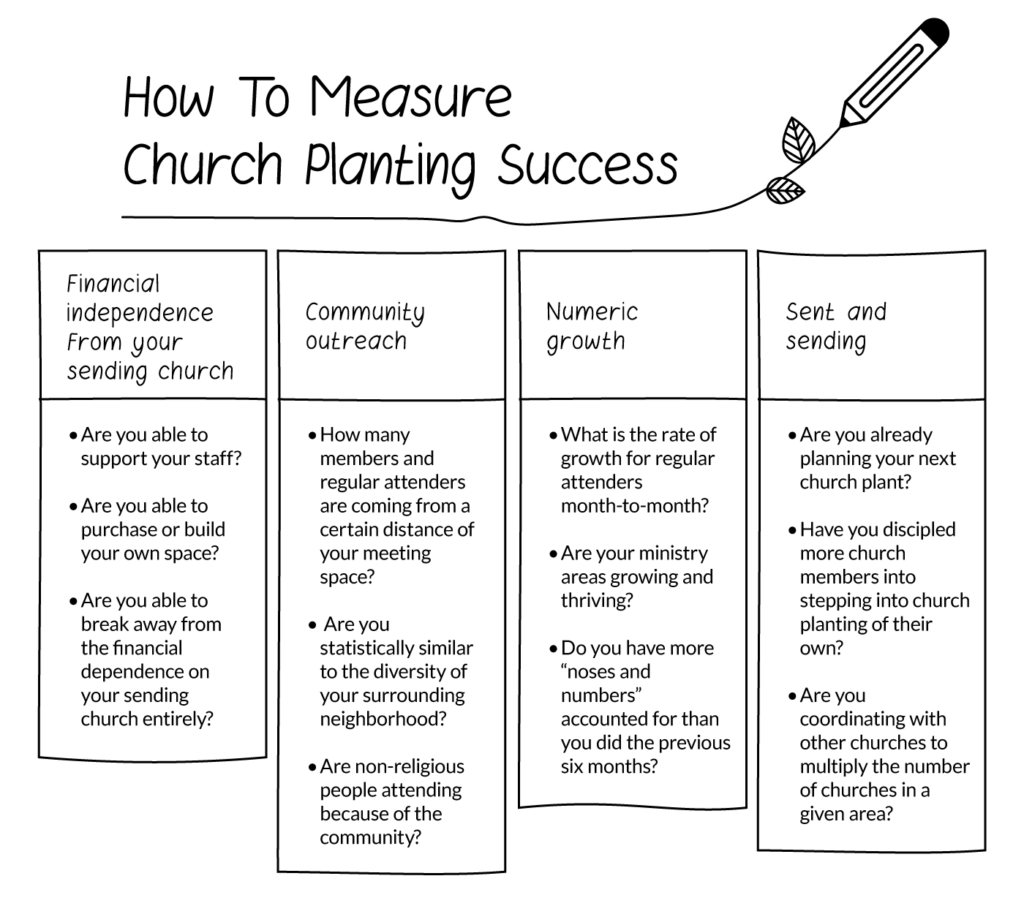When I was in college studying for youth ministry, I thought about what it might look like to get involved with church planting. Growing up in the Church of the Nazarene, I knew that becoming a church planter was a calling that the Nazarene church supported wholeheartedly, but, more importantly, I also knew that there was a church planting network for training and coaching.
If you have been called to church planting in some form or another, then your head might be spinning about what it means to plant a new church. It can seem overwhelming to take a look at the moving pieces involved in a new church plant, but if God has called you to it, then there will be a way to make it happen!
During those college days, I took on an optional course for zero credits in order to become certified in church planting through the Church of the Nazarene. It was called “Organic Church Training.” Some of those lessons have spurred me on to this day, even as I am no longer directly involved with church planting!
By the end of this article, my hope and prayer is that you can feel secure in your understanding of church planting, walk away with some of the best advice for building a new church plant, have clear eyes about the challenges involved in church planting, and know how to track and measure success for your church plant.
I’ll cover:
- What is Church Planting?
- 10 Pieces of Church Planting Advice
- 5 Challenges With Church Planting
- How to Measure the Success of Church Planting
What Is Church Planting?
Let’s begin by defining what we mean by church planting. I find that, often, having a simple definition for a task can help ease many of the expectations we put on ourselves for getting those tasks done.
Church planting is the act of establishing a core group of followers of Jesus Christ who will become a local church acting as the body of Christ in their community.
When you look at this simple definition, it doesn’t sound quite as intimidating. At the core of church planting, you are bringing together people who want to follow Jesus and helping release them into being the body of Christ in their own community.
Now, with that in mind, every new church plant is going to look a bit different. Some might grow to be a typical local church with a lead pastor, regular worship, a growing congregation who gather on Sunday mornings, etc. While others might look like a loosely connected groups of small churches or small groups that meet in homes and public spaces to focus on evangelism and/or discipleship.
There is no wrong way to go about church planting, but there is a “right” way. That “right” way is going to depend largely on the goals you set for your church plant in the far-off future.
If you want a healthy church, then you need to read these church planting tips and pay close attention to the dream God has given you for this group of people you are going to be planting as a church.
10 Pieces Of Church Planting Advice
All church leaders are likely aware of the number of steps involved in planting a church, so this list won’t be a “how-to” guide. These are all pieces of advice to make sure you are planning ahead, staying ahead, and working towards church growth no matter what that looks like for your church plant.
1. Start Fundraising Early
The best time to start working on fundraising when you are considering planting a new church was yesterday. The 2nd best time is today. If you are convinced God has called you to church planting, then you need to start working on raising funds right away.
Start talking about it to people. Don’t worry about having everything set up right away, start giving people the opportunity to give long before you’ve got your tax-exempt status set up. That will only spur you on to take action and get that done for them by the end of the year, so their financial gifts can also help you keep moving forward on the details!
Thank your donors and those offering financial support profusely, involve them in next steps and keep showing them your hard work on this new church plant.
2. Stack Your Launch Team
There is a lot of debate between setting up a “core group” versus a “launch team” and I think that is the wrong conversation. You need to be strategic. A launch team will help you actually launch the new church plant. A core group can do the same thing, functionally, but the language is different. Don’t waste time, effort, or energy on semantics.
That being said, focus on who you want to support the organizational, ideological, and theological health and growth of this church plant.
Those are the people you want thinking through planting a new church. Make sure they are steeped in the word of God, constantly asking for guidance from the Holy Spirit, and more concerned about outreach than the bank account (though, they should focus on the bank account, too)!
3. Further Define a Planting Team
Either out of that launch team or by creating an entirely separate group of people, think early on about who you want to be on your planting team. These are the church members who will be there on day one.
Even if the church plant starts as a Bible study and grows from there, these are the people who may or may not be involved in the logistics of the church plant but know their hearts are set on the mission of this new church plant.
Keep in mind that not all of the people on your launch team may be part of your planting team and that’s okay.
4. Communicate Clearly With Team Members
This should go without saying, but one of the first places that your church plant will succeed or fail is at the hands of your communication. Stay in touch early and often. While you’re at it, make sure you are working on a communication plan for launch as well. Learn from these early experiences to set the tone and improve for the future of this new church plant.
5. Get Involved in the Community
An unfortunate failure for many of those in church planting is that they are not involved enough in the community they are moving into. Sometimes this is tricky with financing, but it has to be done. Whoever is going to be initially leading the new church plant must be entrenched in the local community of the location where the church is being planted.
If you are planting in an area that has little-to-no experience with Christian culture, history, people, etc. then you very well may need to be the first person to show them Jesus in that community. So don’t fret, wear it as a badge of honor. If you’ve worked on fundraising early on, then you should be able to account for a move if need be.
Church planting is not a calling for the faint of heart!
6. Stay On Top of the Legal Material
As I mentioned before, setting up a non-profit and getting tax-exempt status are legal details that you will want to make sure you are staying on top of and working on sooner rather than later. There is nothing worse than getting caught up with your church launch because you don’t have your non-profit status set up and can’t take tithes or other financial support.
Work with a lawyer and accountant early on to make sure these are squared away before they ever become an issue.
7. Organize the Church Leadership Structure Before Launch
This may seem silly because, at the beginning, most of the work will probably fall on either the senior pastor or lead pastor, but plan ahead and be prepared to have an organizational structure in mind for your church plant.
Again, it is so easy with church planting to get focused on the here and now that you overlook preparing for the future. But if you plan on the new church succeeding and sticking around, then shouldn’t you be preparing for that to happen?
In a way, you need to remember that preparing for the future is a sign of your faith in God to make this church plant thrive!
8. Prepare a Space For Your New Church Plant
Every church leader who has ever had to consider finding a new building or physical space to worship has had this struggle. Finding a spot for your regular gathering is difficult, at best. At worst, it is a grueling, stress-inducing nightmare.
Constantly stay ahead of the curve for the need for space and resources. Whenever possible, be stretching for the next growth phase far before you have hit the mark where you need to start working on it.
If you wait until it’s time to change spaces, then you are already too late.
9. Focus Entirely On Evangelism and Discipleship in the Early Days
A local church should always be focusing on outreach, evangelism, and discipleship, but in those early days of church planting people are only going to come when the church members are being taken care of in the first place.
Too often churches stretch for a huge launch day, make it a huge event, and then those attendance numbers make them think that will be the norm. Yet, those numbers will only trickle downwards. However, if they are being discipled well and taught from the word of God and are growing in their journey with the Holy Spirit, then they will keep coming back. Ideally, they will be your outreach plan.
10. Never Be Afraid to Ask For Financial Support
Probably the greatest piece of church planting advice anyone can give is to never stop asking for financial support. Churches have seen record numbers of tithes plummeting, but that’s because these same churches take two approaches to fundraising and financial support:
- God will provide
- Occasionally remind people that the church needs money without explaining what for
While both of these are a part of the process, they should not be the entire ask. Set financial goals for your church plant, address how finances are being used towards those goals, and ask courageously because you know the funds are being used well. Then, when you have done all you can, you can rest in the knowledge that God will provide.
It has to be both, tempered by putting in our own hard work of being humble and asking for support.
5 Challenges With Church Planting

Church planting comes along with a number of challenges. Some church leaders try to blame external sources on the struggles of a new church plant. However, let’s take a look at some of the internal challenges that arise when planting a new church.
If we can address, correct, and overcome these internal struggles, then we can faithfully pursue the work God has placed before us.
- Fear of failure: many church leaders are afraid that they will somehow fail their church plant, but it is this fear of failure that will actually lead to a failed church plant. Overcome this fear by relying on God’s guidance and calling.
- Lack of organization: as discussed earlier, neglecting to plan for the future success of your church plant can actually lead to a premature downfall. Creating an organizational structure your new church can grow into will set up the community for long-term success.
- Fear of discomfort: many church planters, at the core of their being, are afraid of lacking anything. Planting a church is a difficult task that will require some sacrifice. If you aren’t willing to go without certain comforts or expectations, then it will be difficult. Keep focusing on the knowledge that God will provide what you need.
- Unclear mission: while you may know the goals or mission of the new church plant, the people attending might not be fully aware. A failure to communicate this mission often can lead to the eventual burnout of a new church.
- Allowing comparison to steal your joy: comparison is the thief of joy. Don’t look at other churches, other church plants, or other church leaders, and try to compare yourself or your new church to theirs.
Related Read: Recognizing Problems That Arise In Church Planting
How To Measure The Success Of Church Planting

Knowing how to measure success when church planting can be difficult. Do you go off of milestone achievements (like attaining a certain number of baptisms or new attendees)? Do you look at being able to make it a set amount of time (like 6 months, 12 months, or 24 months)?
It’s difficult to know exactly what will be a success for one church as opposed to another. At the top of this article, we talked about how every church is different. That is still true when it comes to measuring the success of your church plant.
Here are a few ways you could define success for your church plant:
- Financial independence from your sending church: are you able to support your staff? Are you able to purchase or build your own space? Are you able to break away from the financial dependence on your sending church entirely? These could all be great markers for success if the goal is to create a brand-new, independent local church.
- Community outreach: how many members and regular attendees are coming from a certain distance of your meeting space? Are you statistically similar to the diversity of your surrounding neighborhood? Are non-religious people attending because of the community? These could all be signs of success for a church focused entirely on evangelism and outreach.
- Numeric growth: what is the rate of growth for regular attendees month-to-month? Are your ministry areas growing and thriving? Do you have more “noses and numbers” accounted for than you did in the previous six months? For churches concerned about becoming a pillar of their community, this might be an important metric to gauge their effectiveness.
- Sent and sending: are you already planning your next church plant? Have you discipled more church members into stepping into church planting of their own? Are you coordinating with other churches to multiply the number of churches in a given area? For a multiplication-focused church, these would be successful results.
This list could go on and on, but the goal is to assess what will be considered a significant “win” in your church planting story and then to keep track of how to get there. Along the way, make sure and catalog every little and big win. These will sustain you and keep you moving forward during the not-so-great times.
Now You’re Ready to Be a Church Planter
Church planting can be scary if you think you are on your own. When you remember that you aren’t ever truly alone, though, then that next step doesn’t seem so difficult. Read more about how to start a church here.
For all things church-related, church planting related, and church management related, The Lead Pastor is here to help and serve. Check out some of our other articles about church leadership or event management and a plethora of other articles on The Lead Pastor! Otherwise, leave a comment and let us know what questions we can try to help answer in the future.



